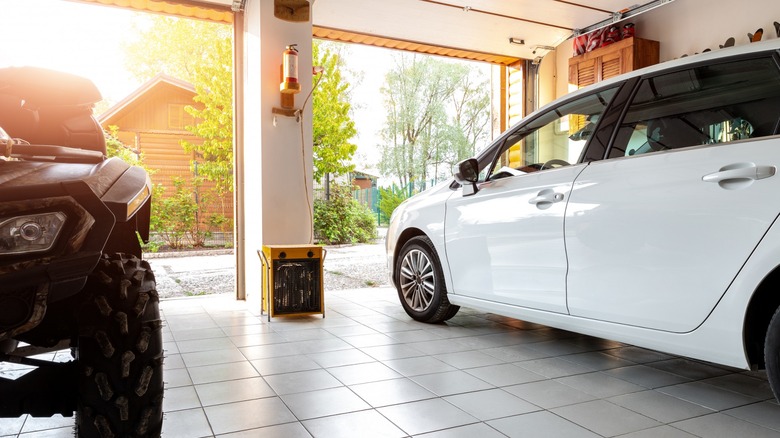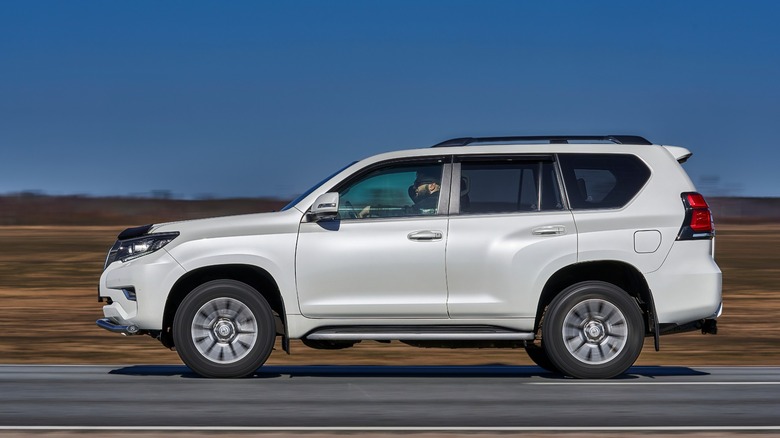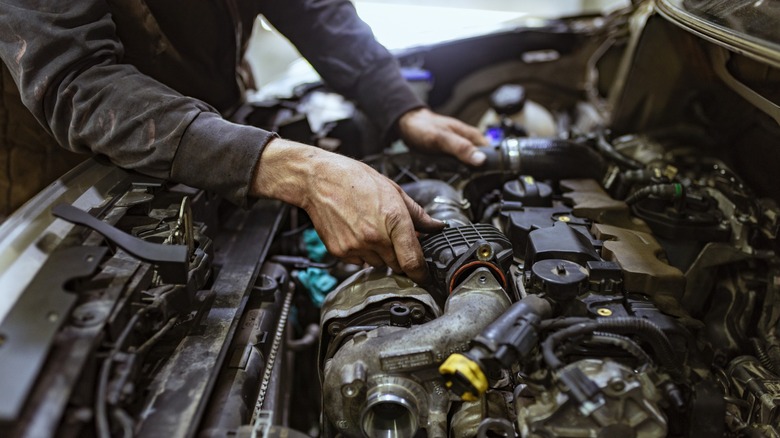How Often Should You Start A Car In Storage?
There are many reasons to put your vehicle in storage. Maybe it's a seasonal ride that you don't want on the road during the winter, or you need to properly protect an investment and your home garage is a little too overcrowded. Regardless of the reasoning, there's a risk that comes with keeping your car locked away out of view: It's out of sight, out of mind, and quite easy to forget.
This may not sound inherently bad. After all, the whole point is to not worry about it, but cars weren't meant to sit in place for a prolonged period. Not too dissimilar to a person, when a vehicle is stagnant for too long, its components can start to deteriorate or become problematic in different ways. That's why Edmunds' seasoned automotive expert and senior consumer advice editor Ronald Montoya suggests that a vehicle in storage should be run every two weeks. Even more than that, though, he states that you should take your car out for a brief 15-minute drive to keep the mechanics running properly.
Your car may look like a metallic behemoth that can withstand just about anything, but underneath the hood is a sensitive system of wires and components that are designed to move.
Why do I need to run my stored car so frequently?
While the two-week suggestion is more of a guideline than a rule and it can vary from model to model, it's something you should take seriously. The main reason? A car battery, like any other battery, will lose charge when it's not used. Though it may be powered off completely, there's an ongoing reaction happening within the battery. Eventually, the power source will self-discharge until it's completely dead.
According to Ronald Montoya, starting and driving your vehicle for 15 minutes keeps the battery charged and prevents corrosion around the terminals. Other experts recommend reducing the time between drives to once a week and increasing the road time to about 30 minutes, but there's no tried-and-true science behind it. Pay close attention to the condition of your vehicle when you start it and base your schedule on whether it seems to be holding up well between drives.
Alternatively, if you're unable to run it periodically, you could disconnect the battery completely or use a "trickle charger," which keeps the battery charged at a very slow rate. However, that only solves one issue that can arise from a sedentary car.
What can happen to my car if left stagnant for too long?
Your battery isn't the only component of your car that isn't made to sit for long. In fact, there are quite a few things that need to keep moving to prevent deterioration, such as your tires.
It's natural for your tires to lose pressure over time, whether they're moving or not, but that's actually not the concern here. If the car isn't driven, the tires can develop flat spots, which are hard patches that develop in parts of the rubber that have had constant contact with the ground. These patches can hinder your car's handling, making it difficult and dangerous to drive. Tires are meant to be occasionally kept in motion to keep them in safe driving condition.
Believe it or not, even your gas can degrade if it sits too long. Exxon, a leading provider of automotive fuel, states that gas shouldn't sit in your car for more than a month. The website goes on to note that when a vehicle won't be run for "an extended period of time," you should drain the tank and run the engine until it stalls. This, however, contradicts other sources, like Firestone Complete Auto Care, which states that an empty fuel tank can lead to moisture accumulation and rust. Firestone recommends storing the vehicle with a full tank to reduce moisture buildup.
Prepping your car for long-term storage
If you're going to store your vehicle, there are a few steps that will ensure it still runs properly when it's time to take it for a spin. Along with prepping the battery and gas tank, as we covered above, you will want to be mindful of the creepy crawlies that may find your car to be a suitable home.
Any stagnant environment is a potential home for spiders, roaches, mice, and anything else that's on the hunt for a safe place to live. While it may be virtually impossible to stop every little creature from finding a secure spot in your car, you can take preventative measures like scattering mothballs throughout. You can also put socks full of sulfur pellets, which are typically used in gardening to keep rodents away. Peppermint is also a natural repellent of rodents and insects, so consider leaving cotton swabs or cotton balls soaked in peppermint oil around your vehicle and garage.
Before you leave your car behind, be sure to also:
- Change the oil so dirty oil is not sitting with contaminates
- Top off all fluids to keep any tank from building up moisture
- Disengage the parking brake to reduce unnecessary wear
- Wrap the wiper blades in plastic to prevent them from getting stuck



